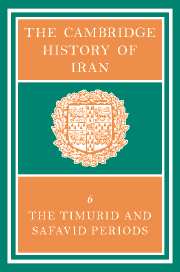Book contents
- Frontmatter
- 1 THE JALAYIRIDS, MUZAFFARIDS AND SARBADĀRS
- 2 TĪMŪR IN IRAN
- 3 THE SUCCESSORS OF TĪMŪR
- 4 THE TÜRKMEN DYNASTIES
- 5 THE SAFAVID PERIOD
- 6 THE SAFAVID ADMINISTRATIVE SYSTEM
- 7 EUROPEAN CONTACTS WITH PERSIA, 1350–1736
- 8 TRADE FROM THE MID-14TH CENTURY TO THE END OF THE SAFAVID PERIOD
- 9 SOCIAL AND INTERNAL ECONOMIC AFFAIRS
- 10 THE EXACT SCIENCES IN TIMURID IRAN
- 11 PERSIAN SCIENCE IN SAFAVID TIMES
- 12 RELIGION IN THE TIMURID AND SAFAVID PERIODS
- 13 SPIRITUAL MOVEMENTS, PHILOSOPHY AND THEOLOGY IN THE SAFAVID PERIOD
- 14 CARPETS AND TEXTILES
- 15 (a) TIMURID ARCHITECTURE
- (b) SAFAVID ARCHITECTURE
- 16 (a) THE PICTORIAL ARTS IN THE TIMURID PERIOD
- (b) THE ARTS IN THE SAFAVID PERIOD
- 17 (a) PERSIAN LITERATURE IN THE TIMURID AND TÜRKMEN PERIODS (782–907/1380–1501)
- (b) HĀFIZ AND HIS CONTEMPORARIES
- (c) PERSIAN LITERATURE IN THE SAFAVID PERIOD
- 18 PERSIAN POETRY IN THE TIMURID AND SAFAVID PERIODS
- Bibliographies
- Plate section
- Plate section
- Plate section
- Maps
- References
(b) - SAFAVID ARCHITECTURE
Published online by Cambridge University Press: 28 March 2008
- Frontmatter
- 1 THE JALAYIRIDS, MUZAFFARIDS AND SARBADĀRS
- 2 TĪMŪR IN IRAN
- 3 THE SUCCESSORS OF TĪMŪR
- 4 THE TÜRKMEN DYNASTIES
- 5 THE SAFAVID PERIOD
- 6 THE SAFAVID ADMINISTRATIVE SYSTEM
- 7 EUROPEAN CONTACTS WITH PERSIA, 1350–1736
- 8 TRADE FROM THE MID-14TH CENTURY TO THE END OF THE SAFAVID PERIOD
- 9 SOCIAL AND INTERNAL ECONOMIC AFFAIRS
- 10 THE EXACT SCIENCES IN TIMURID IRAN
- 11 PERSIAN SCIENCE IN SAFAVID TIMES
- 12 RELIGION IN THE TIMURID AND SAFAVID PERIODS
- 13 SPIRITUAL MOVEMENTS, PHILOSOPHY AND THEOLOGY IN THE SAFAVID PERIOD
- 14 CARPETS AND TEXTILES
- 15 (a) TIMURID ARCHITECTURE
- (b) SAFAVID ARCHITECTURE
- 16 (a) THE PICTORIAL ARTS IN THE TIMURID PERIOD
- (b) THE ARTS IN THE SAFAVID PERIOD
- 17 (a) PERSIAN LITERATURE IN THE TIMURID AND TÜRKMEN PERIODS (782–907/1380–1501)
- (b) HĀFIZ AND HIS CONTEMPORARIES
- (c) PERSIAN LITERATURE IN THE SAFAVID PERIOD
- 18 PERSIAN POETRY IN THE TIMURID AND SAFAVID PERIODS
- Bibliographies
- Plate section
- Plate section
- Plate section
- Maps
- References
Summary
Safavid buildings are preserved in greater abundance than those of any other period in Iran. Yet Safavid architecture is far more imperfectly known than that of the Saljūqs, Il-Khanids or Timurids. Several factors help to explain this paradox. One is quite simply prejudice. The finest Safavid buildings lend themselves to uncritical panegyric and readily enter the unlovely category of tourist attractions, and perhaps for that very reason many of them have not been subjected to detailed scholarly analysis. Alternatively, one might cite the inadequate documentation of Safavid architecture: the relative dearth of monographs, technical drawings and theses in this field makes any general survey premature. A third contributory factor is the over-exposure of a few significant buildings in Isfahān, whose very accessibility is a snare and throws into unjust obscurity comparatively inaccessible work at Ardabīl, Māhān, Kirmān and Mashhad.
This paradoxical neglect of a richly productive period has meant that the term “Safavid” is not yet precise enough to be used safely in the context of architecture. It does not yet connote special kinds of ground plan, spatial organisation, façade composition, muqarnas, arch profiles or vaulting, though it is a widely used concept in the field of tilework. One of the objects of this chapter is to demonstrate that at least three Safavid styles coexisted and that only the function of the building – religious, palatial or otherwise secular – determined which of them should be used.
- Type
- Chapter
- Information
- The Cambridge History of Iran , pp. 759 - 842Publisher: Cambridge University PressPrint publication year: 1986
References
- 4
- Cited by

